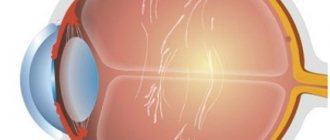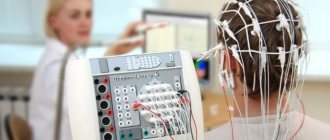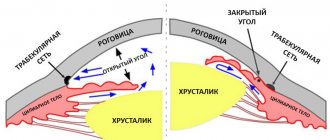How does dry keratitis manifest itself?
Dry eye syndrome requires timely treatment. It is important to seek help from a specialist when the first symptoms appear. Its most common manifestations are:
- increased visual fatigue;
- redness, itching, burning, feeling of “sand” in the eyes;
- increased lacrimation;
- occasional blurred vision.
Typically, dry eyes and a feeling of sand are aggravated by prolonged viewing of TV, working at the computer, or using gadgets. In some patients, symptoms appear while in a smoky room, a room with dry air, as well as in frost and wind.
Depending on the nature of tear production and the severity of symptoms, there are 4 degrees of severity of dry eye syndrome: mild, moderate, severe, especially severe. Regardless of the stage of the disease, it cannot be left without treatment.
Symptoms
Dry eyes are accompanied by many different symptoms, but the main one is a feeling as if the eyes are covered with fine sand. They hurt, itch, dryness of the corneal layer appears, and profuse lacrimation. Associated symptoms are expressed as follows:
- rapid eye fatigue;
- burning and scratching;
- redness of the eye;
- pain and increased sensitivity in bright light.
In the morning, the eyes may stick together and a dried secretion forms on them. Sometimes the patient feels unusual pressure behind the eye.
Why there is a feeling of “sand” in the eyes: reasons for the development of “dry eye” syndrome
Dry eye syndrome occurs in 75% of patients seeking help from specialists. The pathological condition occurs against the background of a violation of the stability of the tear film. In a normal state, the eyeball is covered by a thin film (up to 10 microns) with a heterogeneous structure. It consists of three layers:
- Lipid. Prevents heat transfer from the surface of the epithelial layer of the cornea and conjunctiva, helps prevent excessive evaporation of moisture.
- Watery. It forms the basis of the tear film and is a product of the secretion of the main and accessory lacrimal glands. Contains substances that nourish the organs of vision and are also part of the body's immune defense.
- Mucinous. The most important component of the aqueous layer, which promotes uniform distribution of moisture, has bactericidal properties. Mucins produce goblet cells of the conjunctiva, which help retain the film on the cornea.
If the tear film is not continually renewed, it becomes thin and breaks. This leads to exposure of the cornea, which in turn causes massive cell death from dehydration.
Instability of the tear film causes the eyes to feel dry and sandy, which are common symptoms of dry eye syndrome. There are many reasons for the occurrence of this pathology, both internal and external. These may be age-related changes, disruption of sleep and wakefulness patterns, and a poor diet. Often patients do not pay attention to the increase in dry eyes, which leads to aggravation of the situation.
Dry eyes: how to treat?
One of the main treatments for dry eye syndrome is eye drops (tear substitutes). They may have different composition, consistency, duration of action, and indications. But in general, all drops that replace tears perform one task - temporarily moisturize the cornea. They usually contain the following components:
- Sodium hyaluronate. Prevents dehydration of the corneal surface, eliminates irritation and the feeling of dryness in the eyes for several hours.
- Carbomer. Promotes compaction of the tear film, increases tear viscosity, and eliminates itching.
- Hypromellose. Moisturizes the surface of the cornea, restores its optical properties, eliminates the effect of fogging, irritation and redness of the eyes.
- Dextran. Softens the corneal epithelium, helps restore the thickness of the tear film, and provides long-term comfort.
- Povidone. Reduces redness, irritation, itching, and makes the tear film more stable.
Tear substitutes are available in the form of gels or drops. They may contain preservatives, which often cause additional side effects.
Treatment
Self-treatment often worsens the condition of the eyes and contributes to the development of complications. Therefore, treatment methods should be selected by an ophthalmologist.
As a rule, treatment of pain in the eyes involves an integrated approach. It includes the use of:
- Eye drops containing antibiotics. This is a wide group of drugs that is necessary to fight bacteria, fungi and viruses.
- Antihistamine eye drops. They reduce the manifestation of allergies if the symptoms are caused by allergens entering the mucous membrane.
- Protective and moisturizing drops. Protect the mucous membrane from drying out. These include Gilan, which contains hyaluronic acid. It saturates the tissues with moisture and nutrients.
- Eye ointment. To eliminate pain, ointments are used that reduce inflammation and help tissues recover faster from injuries or burns.
In some cases, the doctor may prescribe vasoconstrictors and antibiotics.
Eye ointments
A common cause of pain is a bacterial or viral infection. For its treatment, special ointments are used, which include antibiotics and antiseptics.
They are in demand among patients due to their effectiveness, relatively low cost, and ease of use. Ointments will be useful for infectious diseases and injuries to the organs of vision.
Drops for pain
Many patients purchase special drops to relieve pain in the eyes. They do provide temporary relief. The disadvantages of such drugs include the addictive effect. Because of it, the tear glands stop producing enough fluid over time.
There is an alternative - Gilan drops with hyaluronic acid. They do not contain harmful preservatives that are addictive. Drops lubricate the surface of the eyes, restoring nutrition to the conjunctiva and cornea, relieving them of discomfort.
Choosing the right eye drops will provide faster symptom relief.
Are there any disadvantages to tear substitutes?
Manufacturers are constantly working to improve the formula of tear replacement products. Numerous studies make it possible to increase the duration of the effect, reduce the risk of side effects, etc. But even the most expensive and closest to ideal products have disadvantages:
- Temporary effect. Gels and drops that replace tear fluid moisturize the cornea and thereby eliminate the manifestations of dry eye syndrome. But with every movement of the eyelid, they flow into the nasolacrimal duct, which again leads to drying out of the cornea.
- Symptomatic treatment. Tear substitutes only work on the symptoms of sicca keratitis. But they are not able to eliminate the causes of the development of this pathology.
- Allergy risk. Allergic reactions, irritation, itching and other side effects are often caused by drops with preservatives. They can even provoke symptoms of dry eye syndrome.
In addition, using drops to relieve “sand” in the eyes and dryness is not always convenient. You will need to constantly look for a place where you can put drops in your eyes while maintaining the sterility of the procedure.
Another problem that users of artificial tears face is an increase in the unpleasant symptoms of dry eye syndrome. But why do dryness and itching become more pronounced if the drops compensate for the deficiency of tears?
The fact is that tear substitutes change the composition of natural tears due to the leaching of mucin from the conjunctival cavity. Therefore, the tear fluid becomes less viscous, unable to perform its physiological functions. Tears diluted with tear substitutes evaporate faster and the eyes begin to experience an acute lack of moisture again.
If you use eye drops with preservatives, especially when you wear contact lenses, the sensation of a foreign body in the eye will rapidly increase. This is because aggressive substances that prolong the duration of the drug destroy goblet cells (responsible for the production of mucin). This again leads to changes in the composition of tears and increased symptoms of dry eye syndrome. Preservatives can also contribute to the development of inflammation of the eye tissue. Therefore, you should not get carried away with using tear substitutes if you do not want to “acquire” new eye diseases.
Cases from practice
Male, 23 years old, graduate student.
In 2009, a young man applied to the Clinical Center for Autonomic Neurology. He studies and works at the university. There is a lot of intellectual load, he reads a lot in print and from the computer. Poor vision: myopia, -4.0 diopters. But I always saw well into the distance.
After entering graduate school, I began to notice that “the letters literally blur before my eyes.” The attacks occurred several times a week for 3-4 minutes while reading. This has been going on for the past 2 months. Sometimes a “veil” appeared when focusing sharply on distant objects. There was a suspicion of cataract, but the diagnosis did not confirm it. Visual acuity remained stable. In addition, since the age of 17, the patient had been bothered by a constant feeling of heaviness in the head, rarely by headaches, as well as tension in the muscles of the neck and back.
Thermal imaging examination revealed disturbances in the functioning of the cervical autonomic nodes and a number of others. After two courses of treatment, the young man felt completely healthy, “like he had never felt before”, “his head became light.” Problems with temporary loss of visual acuity ceased to bother me after the first course of treatment. Tension in the muscles and heaviness in the head completely disappeared in the 2nd month of the recovery period after the second course of treatment.
Male, 42 years old, worker.
The patient contacted us in 2013. After the first attack of autonomic crisis (panic attack) 10 years ago, he developed numerous symptoms of autonomic disorder: heart pain, rapid heartbeat, shortness of breath, problems with blood pressure, stomach, anxiety, dizziness, etc.
After the first panic attack, I immediately went to the doctor, passed all the tests, and underwent a full examination at the cardiology center. The examination showed that the patient is completely healthy. I tried to be treated by a neurologist, visit a psychotherapist, and be treated with various medications - to no avail. For years, the patient tried to fight on his own with sudden attacks of fear, which most often arose in traffic jams, or when the patient, an auto mechanic by profession, was about to repair a car.
Among other symptoms, the man was often bothered by attacks of vision loss and dizziness. If I turned my head back sharply enough and then looked forward again, which often happened while in a moving car, “everything swam before my eyes,” “I fell into some kind of spatial vacuum,” and tinnitus arose.
After the very first treatment sessions at the center of autonomic neurology, anxiety attacks began to bother the patient less frequently and were very short-lived (a few seconds). After the second course, most of the symptoms of autonomic disorder were completely relieved. At the end of the third course of treatment, which the patient considered necessary to undergo to consolidate the result and overall good health, he “felt great.” He did not make any further complaints.
Why can feeling dry eyes be dangerous for your vision?
Dry keratitis requires timely treatment. If the stability of the tear film is not restored in time, the following consequences may occur:
- Decreased quality of life. Any usual activities (driving a car, watching TV, working at a computer) become a real test for sore eyes.
- Damage to the cornea. Violation of the integrity of the tear film leads to the appearance of ulcers, scratches, scars, and inflammation on the surface of the eye. In some cases, they undergo only surgical treatment.
- Eye infections. The tear film is made up of three layers, each of which has specific functions. So the aqueous layer provides reliable protection of the cornea from negative effects. If the stability of the tear film is impaired, it cannot resist viruses and infections.
Fortunately, there is an easy way to combat dry eye syndrome. Regular use of Delfanto® capsules in accordance with the instructions allows you to enhance the production of your own tears in a natural way and relieve dry eyes, which is caused by a deficiency of tears.










